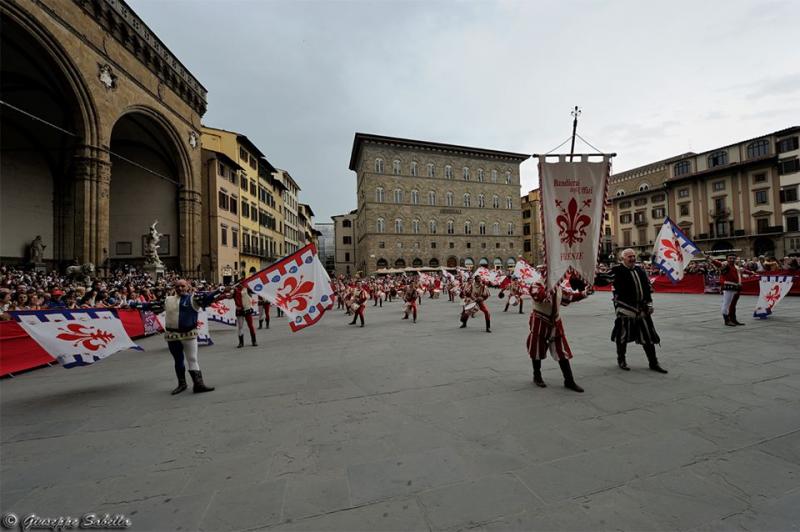Piazza della Signoria in Florence will be taken over by a flurry of colors and flags tomorrow, when the 21st edition of the Trofeo Marzocco is held.
The event, one of the most important flag-waving contests in Italy, is organized by the Bandierai degli Uffizi, the official flag-waving group of Florence.
The contest will see six groups compete for the trophy. They represent both the city/town they come from and their region. Besides the Florentine-based group representing the city and Tuscany, the following sbandieratori (flag-wavers) will take part: Sbandieratori di San Gemini for Umbria, Sbandieratori di Velletri for Lazio, Sbandieratori Sanmarinesi for San Marino, Sbandieratori del Cigno Nero di Rivoli for Piedmont, and Sbandieratori di San Quirico D'Orcia for Tuscany.
 The Trofeo Marzocco is held every year on May 1, in conjunction with Labor Day. According to Florentine tradition, il marzocco is a lion symbol of the people’s power. Its most famous depiction is a sculpture by Donatello, on display inside the Museo Bargello: the lion is seated and with one paw supports the coat-of-arms of Florence, the fleur-de-lys called giglio. A copy of the sculpture is in front of Palazzo Vecchio in Piazza della Signoria, where the flag-waving event is held, as if looking over the event dedicated to such a powerful symbol of the Florentine Republic.
The Trofeo Marzocco is held every year on May 1, in conjunction with Labor Day. According to Florentine tradition, il marzocco is a lion symbol of the people’s power. Its most famous depiction is a sculpture by Donatello, on display inside the Museo Bargello: the lion is seated and with one paw supports the coat-of-arms of Florence, the fleur-de-lys called giglio. A copy of the sculpture is in front of Palazzo Vecchio in Piazza della Signoria, where the flag-waving event is held, as if looking over the event dedicated to such a powerful symbol of the Florentine Republic.
With the important Trofeo Marzocco coming up, ITALY Magazine got in touch with the Bandierai degli Uffizi to find out more about the group’s history and significance. We talked to Antonio Marrone, president of the Amici dei Bandierai degli Uffizi (Friends of Bandierai Association).

Founded in 1973 by Luciano Artusi, who currently serves as the director of the Corteo Storico della Repubblica Fiorentina (Historic Parade of the Florentine Republic), the Bandierai represent, through the symbols on their flags and their historical costumes, the powerful Florentine Republic of the 16th century. Each flag displays in the center the famous symbol of Florence, the red fleur-de-lys on a white background, surrounded by the 16 main ministries – called magistrature – of Renaissance Florence.
The Bandierai count more than 80 members, including children. Every year they hold courses to teach the art of the flag to new members. Flag-waving was practiced by standard bearers of ancient armies both as a way to exercise the body and keep it in shape and as a colorful and cheerful show when special celebrations were held. In the same way, the Bandierai degli Uffizi take part in all major celebrations and parades happening in Florence throughout the year. Last year, they performed at more than 80 events.

One of these is the Calcio Storico Fiorentino (historic Florentine soccer). The sport is thought to have originated in the 16th century in Piazza Santa Croce in Florence, where it became known as giuoco del calcio fiorentino, or simply calcio, the Italian word for soccer. At the time, teams featured members of aristocratic families.
Today, the Calcio Fiorentino is played wearing the costumes of the 16th century as an homage to an important historical event of Florentine history: on February 17, 1530, the population of Florence, which had been under the siege of Emperor Charles V’s troops for months, began playing a game of soccer in Piazza Santa Croce, completely ignoring the troops to launch the message that they were not worthy of attention.
 The modern version of Calcio Fiorentino is a game among the four neighborhoods of Florence: the "Whites" of Santo Spirito, the "Blue" of Santa Croce, the "Red" of Santa Maria Novella and the "Green" of San Giovanni. Three matches are played in the third week of June, with the final played on June 24, the day of the patron saint of Florence. The prize? A white Chianina breed heifer. Every year, the Bandierai carry their flags during the game.
The modern version of Calcio Fiorentino is a game among the four neighborhoods of Florence: the "Whites" of Santo Spirito, the "Blue" of Santa Croce, the "Red" of Santa Maria Novella and the "Green" of San Giovanni. Three matches are played in the third week of June, with the final played on June 24, the day of the patron saint of Florence. The prize? A white Chianina breed heifer. Every year, the Bandierai carry their flags during the game.
If you can’t catch the Bandierai degli Uffizi show off their great skills tomorrow, you can still see them in action this month when they celebrate the second edition of Bandierai Day, a fundraising event for non-profit associations. This year, the event takes place on May 17 and 18 and the proceeds will benefit LILT (Lega Italiana Lotta ai Tumori), an association that fights cancer.
For more information about the Bandierai degli Uffizi, check their website here.

Photos courtesy of Giuseppe Sabella.









